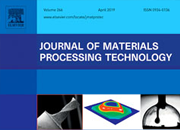
A Journal of Materials Processing Technology destaca-se como uma das revistas mais conceituadas no mundo. Com fator de impacto de 3,647 e Qualis A1, traz o que há de mais novo no desenvolvimento de tecnologias em processos de fabricação e materiais.
O artigo "Effect of Dynamic Wire in the GTAW Process" aborda o efeito da alimentação dinâmica de arame em várias posições de soldagem.
Dados do Artigo
Título: Effect of Dynamic Wire in the GTAW Process
Autores: Régis Henrique Gonçalves e Silva; Kauê Correa Riffel; Marcelo Pompermaier Okuyama; Giovani Dalpiaz
Abstract
Experimental tests were carried out to evaluate and compare metallic transfer aspects and welding process behavior, in GTAW with dynamic wire feeding in relation to conventional mode (wire insertion in a continuous way with constant speed / steady state). Inconel 625 cladded steel plates were laid out at four main welding positions (overhead, vertical up, vertical down and flat). The metallic transfer analysis was based on wire’s tip monitoring, by means of high speed videography and monitoring of the difference of electric potential between tungsten electrode, wire and plate. Continuous wire feeding resulted in rupture of the contact between wire and puddle, which generated large droplets on the wire’s tip, which transferred in irregular intervals. This fact is a common occurrence mainly out of flat position and incurs in irregularity of metal transfer and of oscillographic behavior. For dynamic wire feeding the amount of molten metal in the wire’ tip (droplet) was minimized and the transfer frequency became regular, rendering a more stable and robust process. Also, the risk of electrode contamination was reduced. The benefits of dynamic feeding were observed for both constant and pulsed current.
Keywords: GTAW Technique; Wire Oscillation; Continuous Wire Feeding; Metallic Transfer; Out of Position Welding.
O artigo completo está disponível em: https://authors.elsevier.com/c/1YY4f3I6AlYyWd


